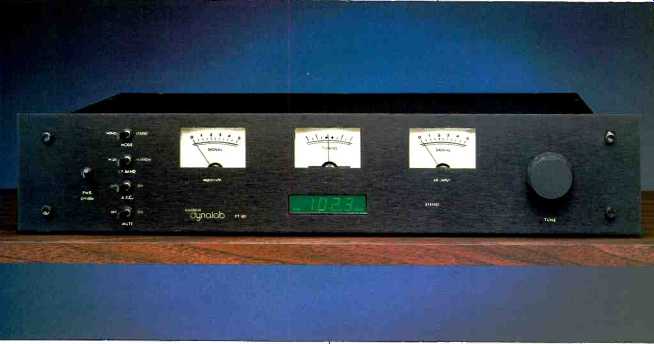
Manufacturer's Specifications
Usable Sensitivity: Mono, 10.3 dBf; stereo, 11.2 dBf.
50-dB Quieting: Mono, 13.2 dBf; stereo, 34.0 dBf.
Frequency Response: 20 Hz to 16 kHz,-3.0 dB.
S/N: Mono, 80 dB.
Alternate-Channel Selectivity:
Wide-band, 55 dB; narrow-band, 75 dB.
Adjacent-Channel Selectivity:
Wide-band, 6 dB; narrow-band, 20 dB.
Image Rejection: 75 dB.
Capture Ratio: 1.5 dB.
AM Suppression: 70 dB.
Wide-Band THD: Mono, 0.1%; stereo, 0.18%.
Wide-Band Separation: 60 dB at 1 kHz.
Antenna Input: 75 ohms.
Power Requirements: 120 V a.c., 75 watts.
Dimensions: 19 in. W x 33/4 in. H x 13 in. D (48.3 cm x 9.5 cm x 33 cm).
Weight: 12 lbs. (5.4 kg).
Price: $549.
Company Address: c/o Castle Marketing, P.O. Box 219, Alexandria Bay, N.Y. 13607.
As a long-time devotee of FM, I must say right up front that the Magnum Dynalab FT-101 tuner gave me a delightful couple of days of experimenting, measuring, and listening.
After all the gadgets-the countless models with more and more presets, frequency synthesis, remote control, and any thing else that imaginative marketers have dreamed up-it was nice to encounter a tuner whose main function is to receive FM stations reliably and with good sound quality.
Finding such features as a center-tune meter, a multipath meter, and a well-calibrated signal-strength meter (one that doesn't hit the peg at the top of the scale when a signal of 501.1A/ or more is received) was, as one of my associates put it, like a breath of fresh air. Add to this the almost unheard-of gift accessory of a legitimate indoor antenna that comes with each FT-101 (instead of the usual limp piece of 300-
ohm transmission line shaped into a T-bar), and I began to feel that here was a little company that really cares about their customers--and about high-quality FM. All of this is so commendable that I am ready to forgive the fact that this fine tuner did not meet some of its published specifications.
Analog tuning is not so common these days, but there are several good reasons for using it. Magnum Dynalab points out that a slight off-station adjustment can sometimes reduce interference (from adjacent-channel signals) and still leave the listener reasonably clean reception. An early spec sheet (since revised) discussed the problem of stations transmitting off their assigned broadcast frequency, a problem which, I gather from the company, may be more common in Canada than in the U.S. Here, where FM broadcast stations are required to be right on frequency (within a few Hz), many cable TV companies use FM-band carriers for stereo soundtracks to accompany their video programs.
These carriers are often on nonstandard frequencies, which frequency-synthesized tuners cannot receive properly. Being able to tune continuously, instead of in 200- or even 100-kHz increments, is a definite advantage in such instances.
Some minor errors in the six-page owner's manual are easily counterbalanced by the obviously sincere motives and dedication of the people at Magnum. I got the feeling that these people care more about delivering an honest product than about their quarterly or annual financial report. Long may they survive!
Control Layout
The 19-inch front panel of the FT-101 tuner is notably devoid of needless pushbuttons, lights, knobs, and fluorescent displays. At the left of the panel are five small toggle switches: A power switch, all by itself, and four others arranged in a vertical row. These handle mono/stereo selection, wide and narrow i.f. modes, a.f.c., and muting. A center-tune meter is fittingly positioned dead-center on the panel; it is flanked by a multipath meter at the left and a signal-strength meter at the right. The one concession to the "digital" age is a four-digit frequency display located below the center-tune meter. Just to the right of the display, below the signal-strength meter, is a "Stereo" indicator which lights up when a stereo signal is received. The only remaining control is a rotary (yes, I said rotary) tuning knob coupled to a nice flywheel for that old-fashioned, smooth tuning feel, albeit without the old traveling dial pointer. There is, incidentally, an FT-101R version that is rack-mountable.
The FT-101's digital frequency display is simply derived from the continuously variable local-oscillator frequency. A three-stage r.f. MOS-FET front-end is employed, and separate i.f. configurations are used for the narrow and wide i.f. modes. With their regular owner's manual, Magnum sent along an interesting bulletin which recommends that users keep the a.f.c. switch off if they live in an area with signal "congestion." As Magnum sees it, a.f.c. does not "lock onto" signals but rater indirectly broadens the pass-band of the tuner. I agree with them up to that point, but then they go on to say that keeping the a.f.c. off "will allow a distant station that is drifting slightly due to atmospherics to be received without unnecessarily bothering the FM-stereo 'blend' or the 'mute' circuitry." Well, that's the first time I've ever heard of "atmospherics" causing a station to drift! What they're apparently referring to is fading or fluctuation in signal strength when the signal is received by ground wave.
A word about the indoor FM antenna packed with each FT-101: In a way, it's almost as interesting as the tuner that it augments. Cleverly constructed of a flexible metal band similar to the metal strip used in those familiar pocket tape measures, the antenna is so assembled that you can pull up on the center of the metal band and thereby reduce the lengths of its two "dipole" rods. The business ends of the metal band remain rigid and extended, and the entire assembly can be rotated for best reception of a desired station signal. The "DX Silver Ribbon" antenna is not manufactured by Magnum but is imported by them for distribution in Canada and the U.S. (They sell it separately as well as supplying it with the tuner.) Since the FT-101 is equipped only with a 75-ohm input, Magnum provides a 300/75-ohm transformer for use with their indoor antenna or with any other 300-ohm antenna system.
Measurements
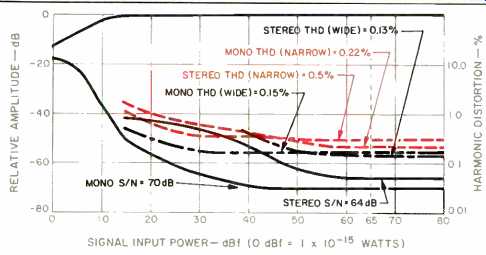
Fig. 1-Mono and stereo quieting and distortion characteristics.
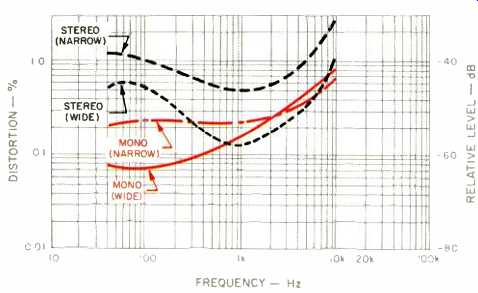
Fig. 2--THD vs. modulating frequency.
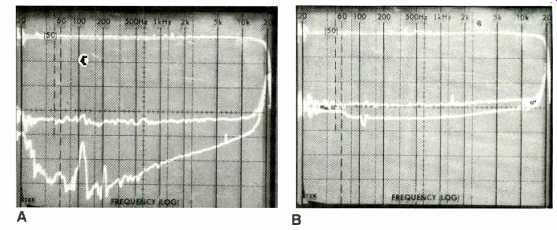
Fig. 3--Frequency response (top traces), separation with weak-signal input
(middle traces), and separation with strong-signal input (bottom traces), for
wide-band (A) and narrow-band (B) i.f. settings.
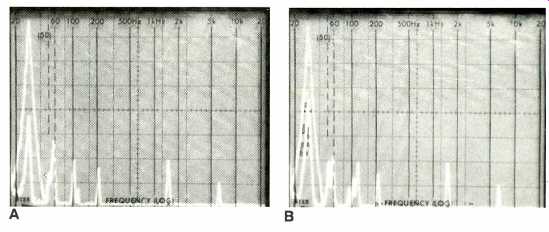
Fig. 4--FM stereo crosstalk and distortion components for a 5-kHz modulating
signal in wide-band (A) and narrow-band (B) modes. Sweep is linear, 5 kHz/div.:
ignore frequency notations on 'scope face.
Though the tuner's performance was respectable, it fell short of meeting some of the manufacturer's published specs. Frankly, I have yet to test any tuner whose sensitivity actually measures 8.8 dBf, the figure on the FT-101's earlier spec sheet. The fact is that 8.8 dBf is approximately equivalent to 1.5 µV across 300 ohms. If Magnum Dynalab had measured 1.5 µV across the tuner's 75-ohm input, it would translate to 14.7 dBf, in which case the 12 dBf I measured on each of two samples tested would have been better than specified. (Incidentally, most measured data given here is for the second unit; the first seemed to be acting up and, we think, not representative of the breed.) In any case, the revised specifications list only dBf figures, and I base my comparisons on these. Usable sensitivity in mono, rated at 10.3 dBf, measured 12.0 dBf. The stereo figure, specified at 11.2 dBf, measured 12 dBf. Sensitivity for 50-dB quieting in mono, specified as 13.2 dBf, measured 15 dBf. In stereo, it was rated at 34.0 dBf and was measured as 38 dBf.
Figure 1 shows mono and stereo quieting and distortion characteristics as a function of signal strength for both the narrow and wide i.f. modes. Note that the FT-101 deals with weak-signal stereo transmissions much as many car-stereo tuners do, blending the stereo channels together as the signals grow weaker to reduce background noise levels.
This accounts for both the rather odd shape of the stereo noise curve in Fig. 1 and the surprisingly good figure I obtained in stereo for usable sensitivity; at the very low signal levels involved in measuring this parameter, the stereo has been blended almost back to mono. The FT-101 is the first home tuner I have encountered which uses this design approach.
With strong signals, mono and stereo S/N were pretty much as expected and did not vary that much when I switched from wide to narrow i.f. modes. Distortion in wide band, mono mode was 0.15%, close to the specified value (and better than the old specification). In stereo, also wide band, distortion measured 0.13%. The fact that the stereo THD figure was a bit lower than the mono reading is not that unusual, but the first FT-101 I tested had lower distortion (0.2% mono, 0.18% stereo) in the narrow i.f. mode than in the wide mode (0.3% mono, 0.25% stereo). This is the opposite of what I would have expected, and I suspect that the first sample's alignment might have been slightly off.
This may well have been the case, as the second unit's distortion did increase as expected in narrow-band mode (to 0.22% mono and 0.5% stereo), and its THD measurements were closer to Magnum's specifications. Figure 2 shows how harmonic distortion varies with frequency for both wide and narrow i.f. settings in mono and in stereo.
Figures 3A and 3B show frequency response and stereo separation. The plots in Fig. 3A were made with the tuner in the wide-band mode; in Fig. 3B, the narrow-band setting was used. In both cases, separation was measured with strong-signal inputs (bottom traces) and then at weaker signal levels of around 40 dBf (middle traces) to demonstrate the "blending" effect used by Magnum. The blending is much more pronounced in the wide-band mode, simply because separation in this mode, with strong-signal inputs, is much greater to begin with. Stereo separation was one characteristic that did exhibit the expected pattern when switching from narrow-band to wide-band i.f. modes. Frequency response (top traces) was exceptionally good, varying by no more than ±0.2 dB from 30 Hz to 15 kHz.
Figures 4A and 4B show distortion and crosstalk products that appear at the unmodulated channel's output when a 5-kHz signal modulates an r.f. carrier to 100%. These photos confirm my earlier findings-that distortion was actually worse in the wide-band mode than it was in the narrow, and that separation was somewhat better in the wide-band mode, as one would expect.
Muting threshold measured 11 dBf, and, although there was no clear stereo threshold because of the blending system, the stereo indicator light turned on for signal inputs as low as 5 dBf.
Alternate-channel selectivity in the narrow- and wide-band modes was almost precisely as claimed, and I was particularly impressed by Magnum's ability to achieve 30-dB adjacent-channel selectivity while maintaining adequate bandwidth for relatively low-distortion reception in the narrow i.f. mode. AM suppression measured 58 dB, as against the 70 dB claimed, and image rejection was close to 80 dB, as opposed to 75 dB claimed. Capture ratio measured 1.5 dB, as claimed, and was substantially the same in both narrow and wide i.f. modes.
Use and Listening Tests
Despite its failure to meet certain published specifications, the Magnum Dynalab FT-101 sounds good and is easy to use. The center-tune meter moved to dead center when signals were tuned precisely to lowest distortion reception. The multipath meter, unlike many such indicators, did move to a minimum reading when my outdoor antenna was oriented for minimum audible multipath effects. As I indicated earlier, the FT-101's signal-strength meter is calibrated so that a listener can get a meaningful idea of actual signal strengths.
The FT-101 will not appeal to everyone. To some, the very simplicity of its front panel might imply a lack of sophistication on the inside. Indeed, if you were to open the top cover of the tuner (as I did), you might be put off by the fact that much of the space inside is empty. Nevertheless, on the basis of its sound and engineering, I do not feel that the price of the FT-101 is particularly out of line. All of which proves that purist audio products don't have to be priced so high that the very people who appreciate them most can't afford them.
-Leonard Feldman
(Audio magazine, Jun. 1986)
Also see:
Magnum 95FM Sleuth FM Antenna Amplifier (Equip. Profile, Aug. 1982)
= = = =